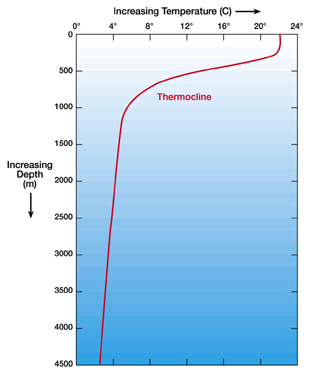Ocean Water Temperature
Most of the solar radiation (light and heat) that penetrates the ocean is absorbed in the first twenty yards
of water. Waves and
turbulence mix this heat downward quickly. The surface layer of the
ocean is mixed from the top to the bottom of that layer. The
temperature
of the
surface waters varies with latitude.
The polar seas can be as cold as -2 degrees Celsius
(28.4 degrees Fahrenheit) while the Persian Gulf can be
as warm as 36 degrees Celsius (96.8 degrees Fahrenheit). The normal
temperature of the ocean surface waters is about 17 degrees Celsius
(62.6 degrees Fahrenheit).
first twenty yards
of water. Waves and
turbulence mix this heat downward quickly. The surface layer of the
ocean is mixed from the top to the bottom of that layer. The
temperature
of the
surface waters varies with latitude.
The polar seas can be as cold as -2 degrees Celsius
(28.4 degrees Fahrenheit) while the Persian Gulf can be
as warm as 36 degrees Celsius (96.8 degrees Fahrenheit). The normal
temperature of the ocean surface waters is about 17 degrees Celsius
(62.6 degrees Fahrenheit).
There is a boundary between surface waters of the ocean and deeper layers that are not mixed. The boundary begins about 100-400 yards and extends several hundred of yards downward from there. This boundary region, where there is a rapid decrease of temperature, is called the thermocline. Ninety percent of the total volume of ocean is found below the thermocline in the deep ocean. Here, temperatures approach freezing. So even though surface waters can be a comfortable 20 degrees Celsius, the majority of our ocean water has a temperature between 0-3 degrees Celsius (32-37.5 degrees Fahrenheit).
The density of ocean water continuously increases with decreasing temperature until the water freezes. Ocean water, with an average salinity of 35 psu, freezes at -1.94 degrees Celsius (28.5 degrees Fahrenheit). Near the polar latitudes, ocean water can reach these low temperatures and freeze. Dissolved salts in the water tend to be rejected by the forming ice so that sea ice is only about 1 % salt. An interesting tidbit for those of you interested in survival tactics - because of the lessened amount of salt, melted sea ice would be fit to drink even if sea water is not! Sea ice formation at high latitudes ultimately drives circulation of the deep waters of the ocean.
